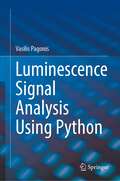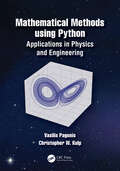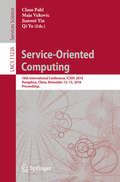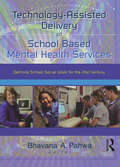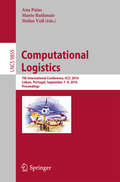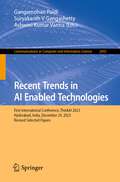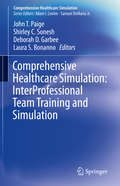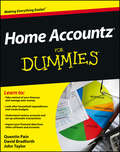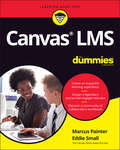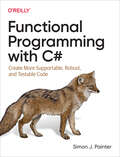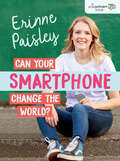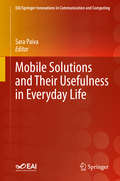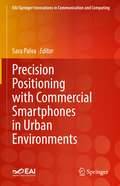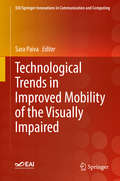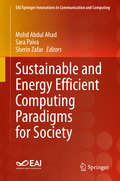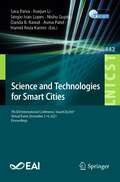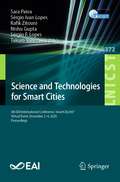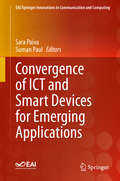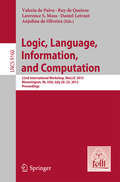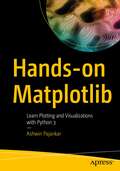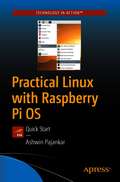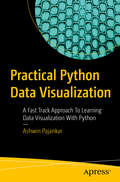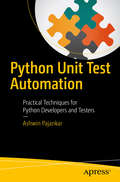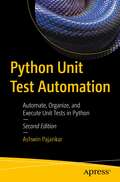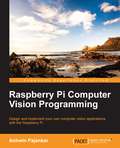- Table View
- List View
Luminescence Signal Analysis Using Python
by Vasilis PagonisThis book compiles and presents a complete package of open-access Python software code for luminescence signal analysis in the areas of radiation dosimetry, luminescence dosimetry, and luminescence dating. Featuring more than 90 detailed worked examples of Python code, fully integrated into the text, 16 chapters summarize the theory and equations behind the subject matter, while presenting the practical Python codes used to analyze experimental data and extract the various parameters that mathematically describe the luminescence signals. Several examples are provided of how researchers can use and modify the available codes for different practical situations. Types of luminescence signals analyzed in the book are thermoluminescence (TL), isothermal luminescence (ITL), optically stimulated luminescence (OSL), infrared stimulated luminescence (IRSL), timeresolved luminescence (TR) and dose response of dosimetric materials. The open-access Python codes are available at GitHub.The book is well suited to the broader scientific audience using the tools of luminescence dosimetry: physicists, geologists, archaeologists, solid-state physicists, medical physicists, and all scientists using luminescence dosimetry in their research. The detailed code provided allows both students and researchers to be trained quickly and efficiently on the practical aspects of their work, while also providing an overview of the theory behind the analytical equations.
Mathematical Methods using Python: Applications in Physics and Engineering
by Vasilis Pagonis Christopher Wayne KulpThis advanced undergraduate textbook presents a new approach to teaching mathematical methods for scientists and engineers. It provides a practical, pedagogical introduction to utilizing Python in Mathematical and Computational Methods courses. Both analytical and computational examples are integrated from its start. Each chapter concludes with a set of problems designed to help students hone their skills in mathematical techniques, computer programming, and numerical analysis. The book places less emphasis on mathematical proofs, and more emphasis on how to use computers for both symbolic and numerical calculations. It contains 182 extensively documented coding examples, based on topics that students will encounter in their advanced courses in Mechanics, Electronics, Optics, Electromagnetism, Quantum Mechanics etc.An introductory chapter gives students a crash course in Python programming and the most often used libraries (SymPy, NumPy, SciPy, Matplotlib). This is followed by chapters dedicated to differentiation, integration, vectors and multiple integration techniques. The next group of chapters covers complex numbers, matrices, vector analysis and vector spaces. Extensive chapters cover ordinary and partial differential equations, followed by chapters on nonlinear systems and on the analysis of experimental data using linear and nonlinear regression techniques, Fourier transforms, binomial and Gaussian distributions. The book is accompanied by a dedicated GitHub website, which contains all codes from the book in the form of ready to run Jupyter notebooks. A detailed solutions manual is also available for instructors using the textbook in their courses.Key Features:· A unique teaching approach which merges mathematical methods and the Python programming skills which physicists and engineering students need in their courses.· Uses examples and models from physical and engineering systems, to motivate the mathematics being taught.· Students learn to solve scientific problems in three different ways: traditional pen-and-paper methods, using scientific numerical techniques with NumPy and SciPy, and using Symbolic Python (SymPy).Vasilis Pagonis is Professor of Physics Emeritus at McDaniel College, Maryland, USA. His research area is applications of thermally and optically stimulated luminescence. He taught courses in mathematical physics, classical and quantum mechanics, analog and digital electronics and numerous general science courses. Dr. Pagonis’ resume lists more than 200 peer-reviewed publications in international journals. He is currently associate editor of the journal Radiation Measurements. He is co-author with Christopher Kulp of the undergraduate textbook “Classical Mechanics: a computational approach, with examples in Python and Mathematica” (CRC Press, 2020). He has also co-authored four graduate-level textbooks in the field of luminescence dosimetry, and most recently published the book “Luminescence Signal analysis using Python” (Springer, 2022).Christopher Kulp is the John P. Graham Teaching Professor of Physics at Lycoming College. He has been teaching undergraduate physics at all levels for 20 years. Dr. Kulp’s research focuses on modelling complex systems, time series analysis, and machine learning. He has published 30 peer-reviewed papers in international journals, many of which include student co-authors. He is also co-author of the undergraduate textbook “Classical Mechanics: a computational approach, with examples in Python and Mathematica” (CRC Press, 2020).
Service-Oriented Computing: 16th International Conference, ICSOC 2018, Hangzhou, China, November 12-15, 2018, Proceedings (Lecture Notes in Computer Science #11236)
by Claus Pahl Maja Vukovic Jianwei Yin Qi YuThis book constitutes the proceedings of the 16th International Conference on Service-Oriented Computing, ICSOC 2018, held in Hangzhou, China, in November 2018. The 63 full papers presented together with 3 keynotes in this volume were carefully reviewed and selected from numerous submissions. The papers have been organized in the following topical sections: Microservices; Services and Processes; Service Trust and Security; Business Services and Processes; Edge + IoT Services; Social and Interactive Services; Recommendation; Service Analytics; Quality of Service; Service Engineering; Service Applications; Service Management.
Technology-Assisted Delivery of School Based Mental Health Services: Defining School Social Work for the 21st Century
by Bhavna PahwaLearn how computer technology is helping school social workers collect information and synthesize it into meaningful data! Technology-Assisted Delivery of School Based Mental Health Services: Defining School Social Work for the 21st Century explores the many technological advances in school social work practices. This book also illustrates the ways technology is being used to manage and evaluate services provided by school social workers. This vital book contains: ways to use new technology to prevent and treat mental health issues in children through safe and effective learning experiences information on how biofeedback can be used to empower children to become more aware of their physical and emotional reactions to environmental stimuli an annotated bibliography of Internet sites covering topics and issues frequently encountered by social workers examinations of exciting software applications, including BARN, From Mad to Worse, Conflict Management, and Smart Team methods of online data collection for use in school social work practices and more!
Computational Logistics: 7th International Conference, ICCL 2016, Lisbon, Portugal, September 7-9, 2016, Proceedings (Lecture Notes in Computer Science #9855)
by Ana Paias Mario Ruthmair Stefan VoßThis book constitutes the refereed proceedings of the 7th International Conference on Computational Logistics, ICCL 2016, held in Lisbon, Portugal, in September 2016. The 29 papers presented in this volume were carefully reviewed and selected for inclusion in the book. They are organized in topical sections entitled: container terminals and maritime transportation; intermodal transport; location and routing; (general) logistics and supply chain management.
Recent Trends in AI Enabled Technologies: First International Conference, ThinkAI 2023, Hyderabad, India, December 29, 2023, Revised Selected Papers (Communications in Computer and Information Science #2045)
by Gangamohan Paidi Suryakanth V Gangashetty Ashwini Kumar VarmaThis book constitutes the refereed proceedings of the First International Conference on Recent Trends in AI Enabled Technologies, ThinkAI 2023, which took place in Hyderabad, India, in December 2023. The 7 full papers presented in these proceedings were carefully reviewed and selected from 51 submissions. The conference focuses on on up to date topics and recent trends in artificial intelligence and related technologies.
Comprehensive Healthcare Simulation: Interprofessional Team Training And Simulation (Comprehensive Healthcare Simulation)
by John T. Paige Shirley C. Sonesh Deborah D. Garbee Laura S. BonannoThis book focuses on InterProfessional (IP) Team Training and Simulation, from basic concepts to the practical application of IP in different healthcare settings. It thoroughly and comprehensively covers the role of simulation in healthcare, human factors in healthcare, challenges to conducting simulation-based IP, logistics, and applications of simulation-based IP in clinical practice. Supplemented by high-quality figures and tables, readers are introduced to the different simulation modalities and technologies employed in IP team training and are guided on the use of simulation within IP teams.Part of the authoritative Comprehensive Healthcare Simulation Series, InterProfessional Team Training and Simulation can be used in training for a variety of learners, including medical students, residents, practicing physicians, nurses, and health-related professionals.
Home Accountz For Dummies
by Quentin Pain David Bradforth John TaylorTake control of your home accounting!Accounting from home can be a difficult task--but not an impossible one with the right tools. Home Accountz For Dummies shows you exactly how to use the UK's number one home finance software to look after household expenditures and effectively budget for a positive future. Author Quentin Pain shows you the ins and outs of managing your money with Home Accountz and this easy-to-understand book provides you with the tools you need to predict future financial capabilities.Explains installation, setup, creating accounts, and connecting to banksTeaches you how to effectively understand accounts, import data from other software, and set up budgetsExplores importing data from software such as Microsoft Money, Quicken, or spreadsheetsCovers dealing with transactions in foreign currenciesAddresses setting up automatic transactionsShows how to watch where your money goes with customizable reportsHome Accountz For Dummies is a fun, easy to use guide that takes the chore out of home accounting and puts you in control of your money.
Canvas LMS For Dummies
by Marcus Painter Eddie SmallMake digital learning effortless with Canvas The potential of digital learning is limitless. But implementing it in the real-world can sometimes be a challenge, especially when you have to learn the ins and outs of a new platform. So, why not choose a learning management system (LMS) that actually makes your life, and the lives of your students, easier? In Canvas For Dummies, a team of expert digital educators walks you through every important aspect of the hugely popular Canvas LMS. Written specifically for busy teachers hoping to make the most of the tools at their disposal, the book offers step-by-step instructions to design, build, and integrate a fully functional Canvas environment. From creating your first classroom home page to taking advantage of Canvas modules, you’ll learn how to use the platform to engage your students and improve their learning. Full of practical guidance and useful tips, this “how-to” handbook helps you: Navigate the creation of a blended learning environment and take advantage of the benefits of both in-person and online learning Manage collaborative environments and leverage Canvas modules to deliver a superior learning experience Integrate your Canvas modules with pre-existing, in-person material to create an intuitive environment This book is an absolute necessity for any educator or parent hoping to improve student outcomes with the powerful tools included in the Canvas LMS.
Functional Programming with C#
by Simon J. PainterAfter decades of relative obscurity, functional programming is finally coming into its own. With concise, easy-to-read code that supports asynchronous, concurrent processing, aspects of functional programming have begun to appear in several traditionally object-oriented languages such as C# and Java. This practical book shows C# programmers how to use functional programming features without having to navigate an entirely new language.Because of the shared runtime environment common to C# and F# languages, it's possible to use most of F#'s functional features in C# as well. Author Simon J. Painter explains how you can write functional code in C# right away, without having to install dependencies or features newer than .NET 3. You'll learn why functional programming concepts can bring immediate benefit to your work.Learn what functional programming is and how it originatedDiscover features of the functional paradigm using a more familiar languageStart coding functionally in C# right away, without relying on third-party librariesWrite code that's more robust, less error prone, and easier to testExamine less conventional ways to look at structures available in C#Explore the practicalities of using functional C# in a business environment
Can Your Smartphone Change the World? (PopActivism #1)
by Erinne PaisleyCan Your Smartphone Change the World? is a twenty-first-century guide for anyone who has access to a smartphone. This how-to manual looks at specific ways you can create social change through the tap of a screen. Filled with examples of successful hashtag campaigns, viral videos and new socially conscious apps, the book provides practical advice for using your smartphone as a tool for social justice. This is the first book in the PopActivism series. Can Your Outfit Change the World? comes out in spring 2018 and Can Your Conversations Change the World? in fall 2018.
Mobile Solutions and Their Usefulness in Everyday Life (EAI/Springer Innovations in Communication and Computing)
by Sara PaivaThis book provides an insight into recent technological trends and innovations in solutions and platforms to improve mobility of visually impaired people. The authors’ goal is to help to contribute to the social and societal inclusion of the visually impaired. The book’s topics include, but are not limited to, obstacle detection systems, indoor and outdoor navigation, transportation sustainability systems, and hardware/devices to aid visually impaired people. The book has a strong focus on practical applications tested in a real environment. Applications include city halls, municipalities, and companies that must keep up to date with recent trends in platforms, methodologies and technologies to promote urban mobility. Also discuss are broader realms including education, health, electronics, tourism, and transportation. Contributors include a variety of researchers and practitioners around the world.
Precision Positioning with Commercial Smartphones in Urban Environments (EAI/Springer Innovations in Communication and Computing)
by Sara PaivaThis book discusses recent technologies and case studies that aim to enhance positioning obtained with commercial smartphones in urban environments, overcoming difficulties with GPS. The authors provide insight into recent trends and innovation on technologies, solutions and approaches to overcome GPS issues in urban environments, due to the existence of a big number of buildings. Topics include security and legal aspects related to positioning systems, the usage of crowdsourcing approaches to enhance positioning, location-based services, proximity based-social networking, satellite navigation and Bluetooth low-energy based systems. The book provides important information for developers that intend to make use of precise positioning for the purpose of commercial applications as well as for research and innovation.Discusses technologies that enhance positioning obtained with commercial smartphones in urban environments;Presents innovations to overcome GPS issues in urban environments caused by dense cities;Includes applications of precise positioning, including their security issues and challenges.
Technological Trends in Improved Mobility of the Visually Impaired (EAI/Springer Innovations in Communication and Computing)
by Sara PaivaThis book provides an insight into recent technological trends and innovations in mobility solutions and platforms to improve mobility of visually impaired people. The authors' goal is to help to contribute to the social and societal inclusion of the visually impaired. The book’s topics include, but are not limited to, obstacle detection systems, indoor and outdoor navigation, transportation sustainability systems, and hardware/devices to aid visually impaired people. The book has a strong focus on practical applications, tested in a real environment. Applications include city halls, municipalities, and companies that can keep up to date with recent trends in platforms, methodologies and technologies to promote urban mobility. Also discussed are broader realms including education, health, electronics, tourism, and transportation. Contributors include a variety of researchers and practitioners around the world.Features practical, tested applications of technological mobility solutions for visual impaired people;Presents topics such as obstacle detection systems, urban mobility, smart home services, and ambient assisted living;Includes a number of application examples in education, health, electronics, tourism, and transportation.
Sustainable and Energy Efficient Computing Paradigms for Society (EAI/Springer Innovations in Communication and Computing)
by Sara Paiva Mohd Abdul Ahad Sherin ZafarThis book provides insights into recent trends and innovation of technologies aiming to provide sustainable and energy efficient computing. The authors discuss approaches to provide solutions to real life societal issues and problems using sustainable and energy efficient computing approaches. The book gathers research and state of the art reviews on solutions for societal benefits by using sustainable approaches of computing. The book also intends to provide use-cases for certain real life societal problems. The book can be used by researchers of similar areas, technologists, environmentalists, educationists, research scholars and UG/PG Students as well.
Science and Technologies for Smart Cities: 7th EAI International Conference, SmartCity360°, Virtual Event, December 2-4, 2021, Proceedings (Lecture Notes of the Institute for Computer Sciences, Social Informatics and Telecommunications Engineering #442)
by Sara Paiva Xuejun Li Sérgio Ivan Lopes Nishu Gupta Danda B. Rawat Asma Patel Hamid Reza KarimiThis book constitutes the refereed proceedings of the 7th Annual SmartCity360° Summit which was organized in November 2021 in Porto, Portugal. Due to COVID-19 pandemic the conference was held virtually. The volume combines selected papers of 6 conferences, namely EdgeIoT 2021 - International Conference on Intelligent Edge Processing in the IoT Era; IC4S 2021 - International Conference on Cognitive Computing and Cyber Physical Systems; SmartGov 2021 - International Conference on Smart Governance for Sustainable Smart Cities; SmartGift 2021 - International Conference on Smart Grid and Innovative Frontiers in Telecommunications; e PFSM 2021 - International Conference on Privacy and Forensics in Smart Mobility. The 45 full papers were carefully selected from 109 submissions. The papers are organized in four thematic sections on Smart Grid and Innovative Frontiers in Telecommunications; Smart Governance for Sustainable Smart Cities; Privacy and Forensics in Smart Mobility; and Sensor Systems and Software.
Science and Technologies for Smart Cities: 6th EAI International Conference, SmartCity360°, Virtual Event, December 2-4, 2020, Proceedings (Lecture Notes of the Institute for Computer Sciences, Social Informatics and Telecommunications Engineering #372)
by Sara Paiva Sérgio Ivan Lopes Rafik Zitouni Nishu Gupta Sérgio F. Lopes Takuro YonezawaThis book constitutes the refereed proceedings of the 6th Annual Smart City 360° Summit. Due to COVID-19 pandemic the conference was held virtually. The volume combines selected papers of seven conferences, namely AISCOVID 2020 - International Conference on AI-assisted Solutions for COVID-19 and Biomedical Applications in Smart-Cities; EdgeIoT 2020 - International Conference on Intelligent Edge Processing in the IoT Era; IC4S 2020 - International Conference on Cognitive Computing and Cyber Physical Systems; CiCom 2020 - International Conference on Computational Intelligence and Communications; S-Cube 2020 - International Conference on Sensor Systems and Software; SmartGov 2020 - International Conference on Smart Governance for Sustainable Smart Cities; and finnally, the Urb-IOT 2020 -International Conference on IoT in Urban Space.
Convergence of ICT and Smart Devices for Emerging Applications (EAI/Springer Innovations in Communication and Computing)
by Sara Paiva Suman PaulThis book focuses on recent topics related to the convergence of information and communication technologies (ICT) and computing with smart devices. Domain areas of application include social, industrial, business development, and day to day life aspects. This book presents chapters related to the aforementioned topics including case studies showcasing future technological trends and challenges. Topics social inclusion solutions and social changes; smart devices and applications for day to day life; smart IoT and applications; and smart cities solutions. The book is applicable to researchers, students, professionals, and professors in a wide range of fields.Focuses on recent developments in ICT and smart devices that pose a clear benefit for users;Presents applications of ICT in education, health, electronics, communication, networking, computing, tourism, transportation;Appeals to researchers, academics, and professionals in a cross section of disciplines.
Logic, Language, Information, and Computation
by Valeria De Paiva Ruy De Queiroz Lawrence S. Moss Daniel Leivant Anjolina G. de OliveiraEdited in collaboration with FoLLI, the Association of Logic, Language and Information this book constitutes the refereed proceedings of the 22nd Workshop on Logic, Language, Information and Computation, WoLLIC 2015, held in the campus of Indiana University, Bloomington, IN, USA in July 2015. The 14 contributed papers, presented together with 8 invited lectures and 4 tutorials, were carefully reviewed and selected from 44 submissions. The focus of the workshop was on interdisciplinary research involving formal logic, computing and programming theory, and natural language and reasoning.
Hands-on Matplotlib: Learn Plotting and Visualizations with Python 3
by Ashwin PajankarLearn the core aspects of NumPy, Matplotlib, and Pandas, and use them to write programs with Python 3. This book focuses heavily on various data visualization techniques and will help you acquire expert-level knowledge of working with Matplotlib, a MATLAB-style plotting library for Python programming language that provides an object-oriented API for embedding plots into applications. You'll begin with an introduction to Python 3 and the scientific Python ecosystem. Next, you'll explore NumPy and ndarray data structures, creation routines, and data visualization. You'll examine useful concepts related to style sheets, legends, and layouts, followed by line, bar, and scatter plots. Chapters then cover recipes of histograms, contours, streamplots, and heatmaps, and how to visualize images and audio with pie and polar charts. Moving forward, you'll learn how to visualize with pcolor, pcolormesh, and colorbar, and how to visualize in 3D in Matplotlib, create simple animations, and embed Matplotlib with different frameworks. The concluding chapters cover how to visualize data with Pandas and Matplotlib, Seaborn, and how to work with the real-life data and visualize it. After reading Hands-on Matplotlib you'll be proficient with Matplotlib and able to comfortably work with ndarrays in NumPy and data frames in Pandas. What You'll LearnUnderstand Data Visualization and Python using MatplotlibReview the fundamental data structures in NumPy and Pandas Work with 3D plotting, visualizations, and animationsVisualize images and audio dataWho This Book Is ForData scientists, machine learning engineers and software professionals with basic programming skills.
Practical Linux with Raspberry Pi OS: Quick Start
by Ashwin PajankarQuickly start programming with Linux while learning the Raspberry Pi OS—the Linux distribution designed specifically for low-cost Raspberry Pis. This short guide reviews Linux commands, GUI, and shell scripting in a holistic manner by diving into both advanced and day-to-day tasks using the Raspberry Pi OS.You'll comfortably work with the Linux command prompt, and explore the RPi OS GUI and all its base applications. Then move into writing your own programs with shell-programming and using high-level languages such as C, C++, and Python 3. You’ll also study hardware and GPIO programming. Use Python 3 for GPIO programming to drive LEDs and pushbuttons.Examples are written in Shell, C, C++, and Python 3. Graphical output is displayed in helpful screenshots that capture just what you’ll see when working in this environment. All code examples are well tested on actual Raspberry Pi boards. After reading this book and following the examples, you’ll be able to write programs for demonstration in your academic/industrial research work, business environment, or just your circle of friends for fun! What You'll LearnNavigate the core aspects of Linux and programming on a Linux platform Install Raspberry Pi OS on a Raspberry PiProgram in Shell, C, C++, and PythonRedirect Io and work with the crontabWho This Book Is ForLinux enthusiasts, software engineers, researchers, business analysts, and managers working with the low-cost Raspberry Pi.
Practical Python Data Visualization: A Fast Track Approach To Learning Data Visualization With Python
by Ashwin PajankarQuickly start programming with Python 3 for data visualization with this step-by-step, detailed guide. This book’s programming-friendly approach using libraries such as leather, NumPy, Matplotlib, and Pandas will serve as a template for business and scientific visualizations. You’ll begin by installing Python 3, see how to work in Jupyter notebook, and explore Leather, Python’s popular data visualization charting library. You’ll also be introduced to the scientific Python 3 ecosystem and work with the basics of NumPy, an integral part of that ecosystem. Later chapters are focused on various NumPy routines along with getting started with Scientific Data visualization using matplotlib. You’ll review the visualization of 3D data using graphs and networks and finish up by looking at data visualization with Pandas, including the visualization of COVID-19 data sets. The code examples are tested on popular platforms like Ubuntu, Windows, and Raspberry Pi OS. With Practical Python Data Visualization you’ll master the core concepts of data visualization with Pandas and the Jupyter notebook interface.What You'll LearnReview practical aspects of Python Data Visualization with programming-friendly abstractions Install Python 3 and Jupyter on multiple platforms including Windows, Raspberry Pi, and Ubuntu Visualize COVID-19 data sets with PandasWho This Book Is ForData Science enthusiasts and professionals, Business analysts and managers, software engineers, data engineers.
Python Unit Test Automation
by Ashwin PajankarQuickly learn how to automate unit testing of Python 3 code with Python 3 automation libraries, such as doctest, unittest, nose, nose2, and pytest. This book explores the important concepts in software testing and their implementation in Python 3 and shows you how to automate, organize, and execute unit tests for this language. This knowledge is often acquired by reading source code, manuals, and posting questions on community forums, which tends to be a slow and painful process. Python Unit Test Automation will allow you to quickly ramp up your understanding of unit test libraries for Python 3 through the practical use of code examples and exercises. All of which makes this book a great resource for software developers and testers who want to get started with unit test automation in Python 3 and compare the differences with Python 2. This short work is your must-have quick start guide to mastering the essential concepts of software testing in Python. What You'll Learn: Essential concepts in software testing Various test automation libraries for Python, such as doctest, unittest, nose, nose2, and pytest Test-driven development and best practices for test automation in Python Code examples and exercises Who This Book Is For: Python developers, software testers, open source enthusiasts, and contributors to the Python community
Python Unit Test Automation: Automate, Organize, and Execute Unit Tests in Python
by Ashwin PajankarLearn how to automate unit tests of Python 3 with automation libraries, such as doctest, unittest, nose, nose2, pytest, and selenium. This book explores important concepts in software test automation and demonstrates how to automate, organize, and execute unit tests with Python. It also introduces readers to the concepts of web browser automation and logging.This new edition starts with an introduction to Python 3. Next, it covers doctest and pydoc. This is followed by a discussion on unittest, a framework that comes packaged with Python 3 itself. There is a dedicated section on creating test suites, followed by an explanation of how nose2 provides automatic test module discovery. Moving forward, you will learn about pytest, the most popular third-party library and testrunner for Python. You will see how to write and execute tests with pytest. You’ll also learn to discover tests automatically with pytest.This edition features two brand new chapters, the first of which focuses on the basics of web browser automation with Selenium. You’ll learn how to use Selenium with unittest to write test cases for browser automation and use the Selenium IDE with web browsers such as Chrome and Firefox. You’ll then explore logging frameworks such as Python’s built-in logger and the third-party framework loguru.The book concludes with an exploration of test-driven development with pytest, during which you will execute a small project using TDD methodology.What You Will LearnStart testing with doctest and unittestUnderstand the idea of unit testingGet started with nose 2 and pytestLearn how to use logger and loguruWork with Selenium and test driven development Who This Book Is ForPython developers, software testers, open source enthusiasts, and contributors to the Python community.
Raspberry Pi Computer Vision Programming
by Ashwin PajankarThis book is intended for novices, as well as seasoned Raspberry Pi and Python enthusiasts, who would like to explore the area of computer vision. Readers with very little programming or coding/scripting experience can create wonderful image processing and computer vision applications with relatively fewer lines of code in Python.
